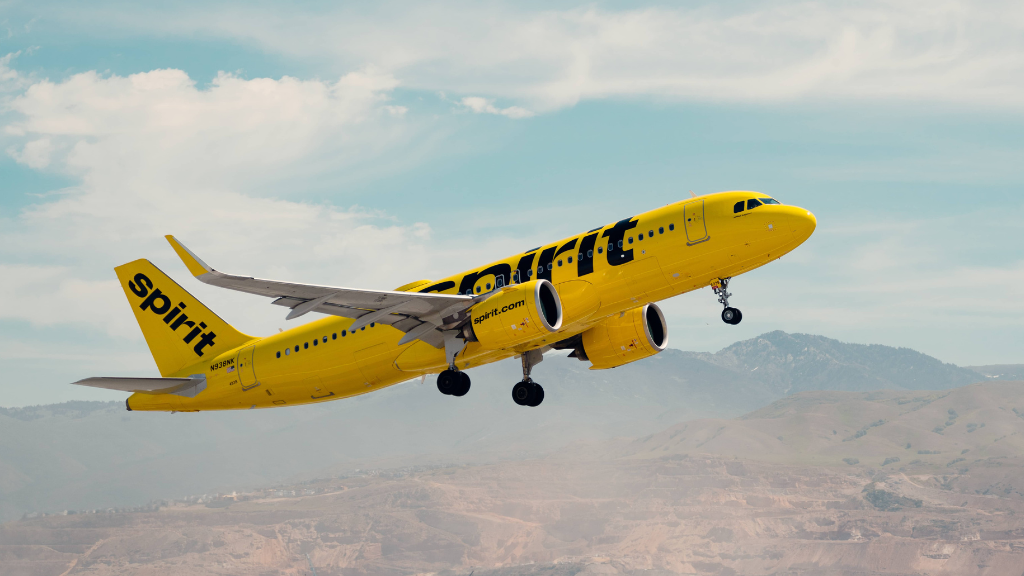Last week, reports surfaced that Spirit Airlines was close to bankruptcy. While bankruptcy is not a sure fate for the airline, major outlets like the Wall Street Journal and Bloomberg report that the budget airline is in dire straits. As of Friday, November 15th, Spirit Airlines is still in talks with creditors. Spirit is widely reported to be looking to restructure its massive debt load with its creditors. Major financial outlets note that this would almost certainly mean the airline would file for Chapter 11 bankruptcy protection.
It goes without saying that this is terrible news for shareholders. Additionally, this news is also understandably quite concerning for the over 13,000 full-time employees at the airline. However, as a traveler, you may also be a bit worried particularly if you have Free Spirit points saved up.
Should Spirit Airlines enter bankruptcy protection, what does this mean for your Free Spirit points? Are you at risk of losing your points? Could this lead to a massive devaluation of the program? Here’s what Free Spirit members need to know about their points should the airline go bankrupt.

Past Airline Bankruptcies and Frequent Flyer Programs
Most reports indicate that should Spirit Airlines “go bankrupt,” the airline would enter Chapter 11 bankruptcy protection. The airline is unlikely to completely cease operations which is usually what happens when a company files for Chapter 7 bankruptcy. The last time a major US airline filed for Chapter 7 bankruptcy (liquidation) was in 2012 when Comair ceased operations.
Comair, which was wholly owned by Delta Air Lines, did not have its own frequent flyer program as it operated as a regional carrier for its parent company. The last time a US airline with a frequent flyer program went into liquidation was during the demise of Aloha Airlines.
Aloha Airlines’ frequent flyer program AlohaPass, ceased operations alongside the airline which meant that members who had not redeemed their miles simply lost them. In Europe, Air Berlin’s topbonus program met a similar fate when the airline filed for insolvency in 2017. While Chapter 7 bankruptcy has always meant the end of an airline’s frequent flyer program, this is usually not the case for airlines that enter bankruptcy protection.
Since 1978, when the airline industry was deregulated in the United States, there appears to be only a single case in which a frequent flyer program was liquidated or dissolved as a result of an airline filing for Chapter 11 bankruptcy protection.
This case involved the rather small low-cost carrier ATA Airlines. ATA Airlines filed for Chapter 11 bankruptcy protection on April 2, 2008, and announced that it would cease operations the following day. Though most of the airline’s assets were acquired by Southwest Airlines, members of the airline’s ATA Travel Rewards program were informed that there would be no way to convert their points to Southwest’s Rapid Rewards program.
Here’s a short list of US airlines that previously declared Chapter 11 bankruptcy and the fate of their frequent flyer programs:
| Airline | Frequent Flyer Program | Entered Bankruptcy | Exited Bankruptcy | Fate of Program |
|---|---|---|---|---|
| Eastern Airlines | OnePass | October 1989 | Ceased Operations | Merged into Continental Airlines program |
| Pan American World Airways (PanAm) | WorldPass | January 1991 | Ceased Operations | Merged into Delta Air Lines SkyMiles |
| Trans World Airlines | Aviators | December 2000 | Merged with American Airlines | Merged into American Airlines AAdvantage |
| Northwest Airlines | WorldPerks | September 2005 | Merged with Delta Air Lines | Merged into Delta Air Lines SkyMiles |
| ATA Airlines | Travel Rewards | April 2008 | Ceased Operations | Unused points were canceled |
| American Airlines | AAdvantage | November 2011 | December 2013 | Unchanged |
| PenAir (part of RavnAir Group) | FlyAway Rewards | August 2017 | Ceased Operations | Merged into RavnAir program |
At this point, following waves of massive airline mergers in the 2000s, nearly every major US airline would stay afloat for the foreseeable future if it entered Chapter 11 bankruptcy protection. US airlines are just so large that debt restructuring isn’t likely to result in the end of an airline.
So, this is at least some good news for travelers and members of the airline’s Free Spirit program. Still, even if the airline filed for bankruptcy and kept flying, this doesn’t necessarily mean the airline’s loyalty program would go unscathed.
Amazon Basics 30-inch Expandable Hardside Luggage – $74.49 (32% Off) – View Deal
Bowers & Wilkins Noise Canceling Headphones – $249.43 (37% Off) – View Deal
Sony Wireless Premium Noise Canceling Headphones – $198.00 (43% Off) – View Deal
Samsonite 2-Piece Hardside Expandable Luggage Set – $158.22 (49% Off) – View Deal
What Past Airline Bankruptcies Can Tell Us About the Free Spirit Program
Given that, only a single US airline that had filed for Chapter 11 bankruptcy ended up dissolving its frequent flyer program, there is a precedence. That is, as long as an airline remains operational or there is a plan in which assets are sold off to another airline, your points and miles are probably safe. But this is not a sure bet. Also, being safe doesn’t mean your points or miles would retain their value.
Frequent flyer programs are a massive business and can often rival the value of some of an airline’s other assets. For example, American Airlines’ AAdvantage program is valued somewhere between $18 and $30 billion. Compare that to the airline’s actual market capitalization which, as of November 15th, is around $9.46 billion.
Of course, Spirit Airlines is much smaller than American Airlines and its Free Spirit program pales in comparison to the AAdvantage program. Nevertheless, the Free Spirit program is a well-established loyalty program. Unfortunately, there are no figures available for just how much the program is worth or how many members the program has.
In a financial document filed in late 2023, Spirit Airlines states that “The success or failure of our business will have a direct impact on the success and the value of the Free Spirit Program and the Spirit Saver$ Club® program.” It notes that any changes made to the Free Spirit program could impact the airline’s relationship with Free Spirit program partners and members. The airline recognizes the value of the frequent flyer program to its overall business.

So, What Does This Mean for My Spirit Points?
In short, your Spirit points are probably safe. That is, at least for the time being. There are risks in holding a large reserve of any loyalty program currency. Just like gift cards, your frequent flyer miles can become completely useless should a company or its loyalty program cease to exist.
If, for whatever reason, a bankruptcy court views an airline’s frequent flyer program as a burden, it could, in theory, require the airline to dissolve the program. But this has yet to happen. There does not appear to be a case in which a US bankruptcy court ordered an airline to dissolve its loyalty program. Additionally, dissolving the program to prevent members from redeeming points for air travel could be more detrimental to a bankrupt airline’s bottom line than a member redeeming their points.
Should I Redeem My Spirit Points Now?
There’s still a lot of uncertainty over the future of Spirit Airlines. Even with this uncertainty, unless you have a reason to book a flight, you shouldn’t rush to burn through your Free Spirit points. Again, it’s highly unlikely that your points are going to become useless even if Spirit files for bankruptcy.
While it’s unlikely your points become completely useless, they could still lose value. There are two ways in which your Spirit points could lose value if the airline enters Chapter 11 bankruptcy protection.
A Smaller Network Means Fewer Options for Award Flights
If Spirit Airlines were to file for bankruptcy, it’s possible that it would be forced to terminate leases or sell off owned aircraft. This would mean the airline’s network would become smaller. While this doesn’t directly impact the value of Free Spirit points, having fewer flights on which to redeem your points ultimately means your points are less valuable. Fewer seats, fewer destinations, and fewer flights are not good for frequent flyers looking to book an award flight.
Program Devaluations Are Never Out of the Question
When it comes to frequent flyer programs, airlines have a lot of control over the program. It’s also not out of the question that, to reduce the number of award redemptions and cut costs, the Free Spirit program is devalued. But, as previously mentioned, during bankruptcy, the last thing a company would want to do is upset its most loyal customers. So, a devaluation also seems somewhat unlikely.
Related: How Many Spirit Points Do You Need for an Award Flight?
The Bottom Line
While Spirit Airlines’ financial struggles and potential bankruptcy have raised concerns, history offers a reassuring precedent: frequent flyer programs often survive Chapter 11 bankruptcy filings. For Free Spirit members, this means your points are likely safe for now. However, there are risks to holding onto a large reserve of points in any program, especially one tied to a company facing financial uncertainty.
The potential outcomes include a smaller route network, which could limit award flight availability, and the possibility of program devaluation. While a complete dissolution of the Free Spirit program seems improbable, it’s important to remain cautious. If you have specific travel plans, redeeming your points sooner rather than later might provide peace of mind.
Ultimately, Spirit Airlines’ fate remains uncertain, and its Free Spirit program’s future depends on how potential bankruptcy proceedings unfold. For now, keep an eye on developments, consider your travel needs, and use your points strategically to ensure you get the most value.
Do you have any Free Spirit Points? If so, what are your plans for your Free Spirit Points?












